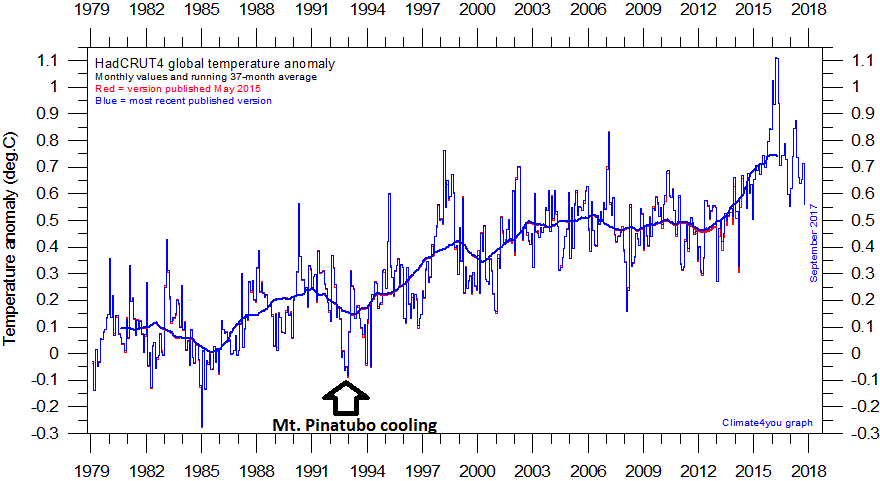11:55 AM | *Bali (Indonesia) volcano can have important ramifications on global temperatures*
Paul Dorian
Ash and smoke pouring out of Mount Agung and high up into the atmosphere over the tropical island of Bali, Indonesia..
Overview
Mount Agung on the Indonesian island of Bali is showing increasing signs of heading towards a full-scale eruption. For the last several months, Bali’s largest volcano Mount Agung has been rocked by hundreds of earthquakes and in recent days has begun to spew ash and smoke high up into the atmosphere over this tropical island. If there is indeed a major eruption in this part of the world, it could have a significant impact on global temperatures for up to a couple of years. Mount Agung is one of more than 120 active volcanoes across Indonesia in the so-called Pacific “ring of fire”.
Global monthly average surface air temperature since 1979 according to Hadley CRUT, a cooperative effort between the Hadley Centre for Climate Prediction and Research and the University of East Anglia's Climatic Research Unit (CRU), UK. The thin line represents the monthly values, while the thick line is the simple running 37 month average, nearly corresponding to a running 3 yr average. The eruption of the Mount Pinatubo volcano in June 1991 caused global cooling through 1992 (indicated by arrow). Courtesy "climate4you.com"
Discussion
Mount Agung last erupted in 1963 sending a plume of ash some 15 miles into the atmosphere. Since Mount Agung is located near the equator where the sun's rays are the strongest, a major eruption with ash flying up into the stratosphere could have important temporary climatic temperature impacts on the order of a couple of years. In fact, the last major eruption of Agung led to a global cooling of 0.5°C during the following few years. Similarly, the eruption of Pinatubo in the Philippines in 1991 led to a global cooling of around 1.0°C following that event. When volcanoes erupt, they emit a mixture of gases and particles into the air. Some of them, such as ash and sulphur dioxide, have a cooling effect, because they (or the substances they cause) reflect sunlight away from the earth.
How much a volcanic eruption cools the planet is hard to predict as it depends on the amount of material it erupts, how high it reaches, and the composition of that material. In addition, there are other complicating factors to consider with respect to volcanic eruptions and their impact on the atmosphere. For example, volcanic eruptions will emit methane and CO2 into the atmosphere and these can play an important role in the upper part of the atmosphere. In fact, there are estimated to be around 1500 or so active terrestrial volcanoes, but an unknown number of undersea volcanoes and methane is known to escape naturally from the sea floor in places all around the world.
The alert for the volcano which has been spewing huge columns of ash and smoke as high as 13,000 feet has been raised to the highest level suggesting fears of a significant eruption. Authorities have widened the exclusion zone around Mount Agung to 6 miles (10km) and have told people living nearby the mountain to immediately evacuate.
Meteorologist Paul Dorian
Vencore, Inc.
vencoreweather.com


